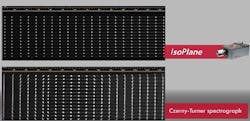Trenton, NJ--Princeton Instruments has introduced a new toroidal-mirror-based imaging spectrograph that includes a Schmidt corrector in its optics, completely eliminating astigmatism across the field. The IsoPlane SCT-320 was unveiled at The Optical Society’s Conference on Lasers and Electro-Optics (CLEO) 2012 (San Jose, CA) on Tuesday, May 8.
The instrument’s f/4.6 optical design (which is patent-pending) allows it to produce near-Lorentzian spectral lines across the image plane and image 16 line pairs per millimeter across the entire field. This imaging quality is approaching the limit on resolution set by the pixel size of the imaging detector itself, which is 25 line pairs per millimeter. Because more photons end up in the spectral peaks, the signal-to-noise ratio is increased.
“Getting rid of field astigmatism allows up to 200 channels,” says Jason McClure, chief scientist at Princeton Instruments and designer of the optics.
The design of the IsoPlane SCT-320 is a modification of the classic Czerny-Turner design, dubbed the Schmidt-Czerny-Turner (SCT). McClure notes that the SCT design could allow imaging across an entire microscope field and could enable using a large 1” camera rather than a standard 8 mm camera.
Applications for the IsoPlane spectrograph include include multichannel spectroscopy, microspectroscopy (including Raman spectroscopy, fluorescence and photoluminescence), laser-induced breakdown spectroscopy (LIBS) and similar high-resolution techniques, Fourier-domain spectroscopy, and biomedical imaging.
Princeton Instruments says it is taking orders now and shipping in July.
For more info, see http://www.princetoninstruments.com/products/spec/isoplane/default.aspx

